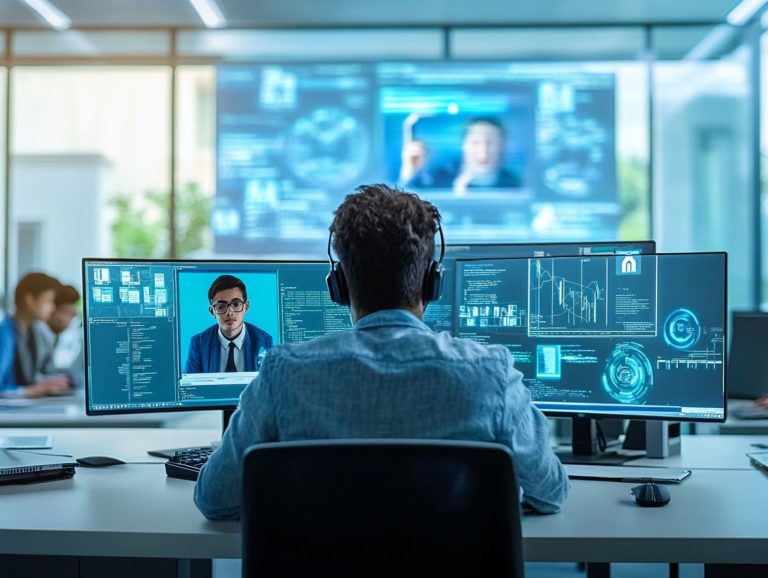What Technology is Needed for Online Learning?
As online learning continues to reshape education, understanding the technology that underpins it is essential.
From the devices you use to the software that facilitates communication, selecting the right tools can significantly enhance your learning experience.
This article explores the core components of online learning technology, covering necessary hardware, software applications, and the critical role of reliable internet connectivity.
You ll also discover cutting-edge advancements, such as virtual reality, that redefine learning in a digital environment.
Whether you’re a student, educator, or tech enthusiast, you ll find insights that empower you to navigate the digital learning landscape with confidence.
Contents
Key Takeaways:

Having the right hardware, such as a reliable device and necessary accessories, is crucial for successful online learning.
Using communication and collaboration tools, along with learning management systems (platforms that help manage courses online), can enhance the online learning experience for both students and teachers.
Internet connectivity is vital, with a minimum speed and reliable connection necessary for a smooth and effective learning experience.
Overview of Online Learning Technology
Online learning technology has transformed education, offering innovative solutions that meet the growing demand for remote instruction.
This evolution shows the emergence of diverse educational technology tools designed to facilitate distance education and boost academic engagement.
With platforms like Google Classroom and G Suite for Education, you can create interactive learning experiences that leverage digital resources and assistive technology, enriching the educational journey.
Definition and Purpose
Online learning marks a big change in education, using digital platforms and tools to deliver high-quality education remotely, allowing access to learning opportunities from anywhere, at any time.
This innovative approach breaks geographical boundaries and caters to different learning styles, offering a more personalized educational experience.
In our fast-paced, technology-driven world, online learning is increasingly essential, effectively meeting the needs of students and educators.
It enables you to engage with course materials at your own pace, fostering a deeper understanding of subjects through interactive resources.
Instructors can use educational technology to enhance remote instruction, providing real-time feedback and encouraging peer collaboration.
The flexibility of online learning also supports lifelong education, enabling you to continuously update your skills in an ever-evolving job market.
The Importance of Hardware
To engage fully in online learning, you and your educators need to meet specific hardware requirements that ensure smooth access to digital resources.
This means having the right computer hardware, such as laptops or desktops, along with essential accessories that enhance interaction in virtual classrooms.
Understanding these requirements is vital for maximizing your technology proficiency and ensuring effective educational experiences.
Devices and Accessories
Essential devices for your online learning journey include laptops, desktops, tablets, and smartphones, complemented by accessories like headphones, webcams, and microphones to enhance interaction.
These devices make coursework accessible from virtually anywhere and cater to various learning styles, accommodating visual, auditory, and kinesthetic preferences.
Tablets offer portability and touch functionality, perfect for interactive learning apps, while laptops provide the power and screen size needed for multitasking during online lectures.
Investing in quality headphones can significantly enhance your audio experience, ensuring you catch every important detail.
High-definition webcams enable clearer communication and foster personal connections in virtual classrooms.
The thoughtful integration of these tools transforms your online learning experience, creating a collaborative environment where you can engage effectively and feel like an active participant in your education.
Software and Applications for Online Learning

Software applications are essential in the realm of online learning, providing a diverse array of educational apps and learning management systems. These tools improve communication and foster collaboration. They also simplify course management.
Communication and Collaboration Tools
Communication and collaboration tools are vital in online learning environments, enabling you to engage in effective dialogue and teamwork alongside fellow students, educators, and online instructors.
These tools bridge the gap, connecting you with participants all over the globe and breaking down the traditional barriers of the classroom. With options like video conferencing platforms, instant messaging apps, and collaborative document editing software, you can dive into real-time discussions and share resources with ease.
Take platforms like Zoom, for example they facilitate live classes and interactive sessions that keep you involved. Meanwhile, Google Workspace allows you to collaborate on projects seamlessly, making teamwork a breeze.
By integrating these technologies, not only does the learning experience elevate, but you also ensure that everyone has a voice, creating a more inclusive and engaging educational environment.
Learning Management Systems
Learning Management Systems (LMS) are platforms that help manage online courses, providing a clear and organized space for online education. They enable you to manage course content, monitor student progress, and create personalized learning experiences.
These platforms come packed with a variety of powerful features designed to streamline the entire educational journey. You can effortlessly integrate multimedia content, quizzes, and interactive discussions, all of which enhance student engagement.
Analytics tools help you see how students are performing, pinpointing areas that may need improvement. Many LMS also include communication tools that encourage collaboration and provide timely support.
This comprehensive approach not only boosts your course management efficiency but also enriches the overall learning experience, making it adaptable to individual needs in today s technology-driven landscape.
Internet Connectivity for Online Learning
Reliable internet connectivity serves as the foundation of successful online learning. It guarantees consistent access to essential digital resources and fosters seamless communication between you and your educators.
Minimum Speed and Reliability
For you to truly excel in online learning, a minimum internet speed is essential to support video streaming, interactive sessions, and effective communication. Generally, it’s advisable to have at least 5 Mbps for standard video conferencing. However, if you’re diving into group sessions or high-definition content, you might need speeds ranging from 10 to 25 Mbps for a truly seamless experience.
Internet reliability is equally important; intermittent connections can disrupt your learning flow, leading to unnecessary frustration and hindering your ability to absorb knowledge effectively. While students with strong tech skills may be better at troubleshooting issues, no amount of proficiency can replace the need for a stable connection to keep you engaged.
As online education rapidly evolves, understanding these needs is crucial for a rich and productive learning experience.
Additional Technology for Enhanced Online Learning

Along with foundational tools, you’ll discover that advanced technologies like virtual reality and artificial intelligence are increasingly woven into online learning environments. These innovations offer sophisticated teaching tools that significantly enhance student engagement and improve learning outcomes, transforming the educational experience into something truly dynamic.
Virtual and Augmented Reality
Virtual reality (VR) creates a completely digital environment, while augmented reality (AR) adds digital elements to the real world. These game-changing tools elevate your online learning experience, making abstract concepts more tangible and engaging.
They capture your attention and significantly enhance your understanding of complex subjects. Imagine exploring a cell in 3D! This hands-on experience makes complex biology come alive.
In history classes, AR applications let you interact with ancient artifacts through your smartphone, creating a vivid connection to the past.
By integrating these advanced educational technologies into the curriculum, you promote collaboration, critical thinking, and creativity essential skills for the modern workforce.
Artificial Intelligence and Adaptive Learning
Artificial intelligence (AI) is revolutionizing online learning through adaptive learning systems that customize educational content to fit your unique needs.
These systems assess your progress, preferences, and comprehension levels, dynamically adjusting the curriculum in real time to enhance your engagement and retention.
This tailored approach not only boosts the effectiveness of your learning but also identifies any gaps in your knowledge, providing targeted support exactly where you need it most.
The implications for your success are significant: increased personalization translates to heightened motivation, improved performance, and ultimately, better outcomes.
As these adaptive technologies evolve, they reshape the landscape of educational technology, creating a more dynamic and inclusive learning environment that equips you for future challenges.
Frequently Asked Questions
What Technology is Needed for Online Learning?
- A computer or laptop
- A reliable internet connection
- Specific software or applications
Is a Computer or Laptop Necessary for Online Learning?

Yes, you need a computer or laptop to learn online.
What Type of Internet Connection is Required for Online Learning?
A reliable and stable internet connection is necessary. A minimum download speed of 2 Mbps is recommended, but higher speeds are better for video conferencing and streaming lectures.
Do I Need to Purchase Special Software for Online Learning?
The specific software or applications needed will depend on your course or program. Some may require specialized software, while others only need standard programs like Microsoft Office.
Can I Use a Mobile Device for Online Learning?
While a mobile device can be used for some aspects, such as checking emails or accessing online platforms, a computer or laptop is recommended for a better learning experience.
Are There Any Other Essential Technologies for Online Learning?
In addition to a computer, internet connection, and necessary software, having a webcam and microphone is beneficial for participating in video lectures and online discussions.






